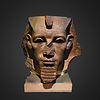It’s really inspiring to see more and more forward-thinking cultural institutions like The Met Museum, The Smithsonian or The Balkan Heritage Foundation enter the 3D realm. In the past 2 years, they all made part of their artifacts available for download and 3D printing as 3D files and the process is ongoing.
Imagine how this will change a students experience in the history class. Besides history books, exciting trips to the museums and the recent Google Art Project, students can now experience busts, statues or sarcophagi first hand thanks to 3D scanning and, ultimately, local 3D printing.
I guess what I mostly looking forward is seeing students taking these files to the next level, seeing them become the creators by doing mashups of these glorious art works. But I’ll leave this for some other time ![]()
Until then, here are some examples of how history teachers can spark their students’ curiosity, which will ultimately enable them to build observation and critical thinking skills.
Granite head of Amenemhat III
This head comes from one of two large seated statues of Amenemhat III (1854-1808 BC) that flanked the entrance to the temple at Bubastis in Egypt. Fragments of the lower part of this statue are also in the British Museum, while the head of the second statue is now in the Cairo Museum.
Stone Chinese Guardian Lions
You’ll find these traditional statues of guardian lions usually in pairs in front of all Chinese palaces, tombs, government offices or temples. They were believed to have powerful mythic protective benefits and are now available for download thanks to the National Cheng Kung University Museum.
The Gate of the Kiss
Constantin Brancusi is probably the most important sculptor of the 20th century and The Gate of Kiss, an arch of triumph in the Roman style, is testimony to this.
Dragon Boat
They were traditionally made in the Pearl River Delta region of China’s southern Guangdong Province out of teak wood (mostly imported from Pontianak, Indonesia) to various designs and sizes.
African Oro Helmet Mask
Masks of this type were used during annual festivals. And the many figures on top of the mask, including a prisoner, a preacher, a musician and a soldier indicate that these African Oro activities involve the whole community.
Adam
You can see this 2 metre tall statue from the 19th century on the Notre Dame building in Paris, together with other 27 Biblical characters.
Easter Island Moai Statue
Easter Island, one of the most remote islands uninhabited by people, is known for its huge, ancient carved stone statues called moai.
Statue Of Edward Snowden
Probably the greatest hero of our times, Edward Snowden had his statue temporarily placed in Brooklyn Park one morning by a group of anonymous artists, only to be removed by the authorities in the afternoon. This basically makes the perfect case on how 3D printed artwork grants everyone access to ephemeral art.
Check out the Sketchfab Museum 1 collection for more examples.
Do you know of any teachers using 3D printing in their class? Do you see kids enjoying such experience?
Share in the comments!
created
Nov '15last reply
Nov '15- 5
replies
- 1.5k
views
- 3
users
- 14
likes
- 1
link
